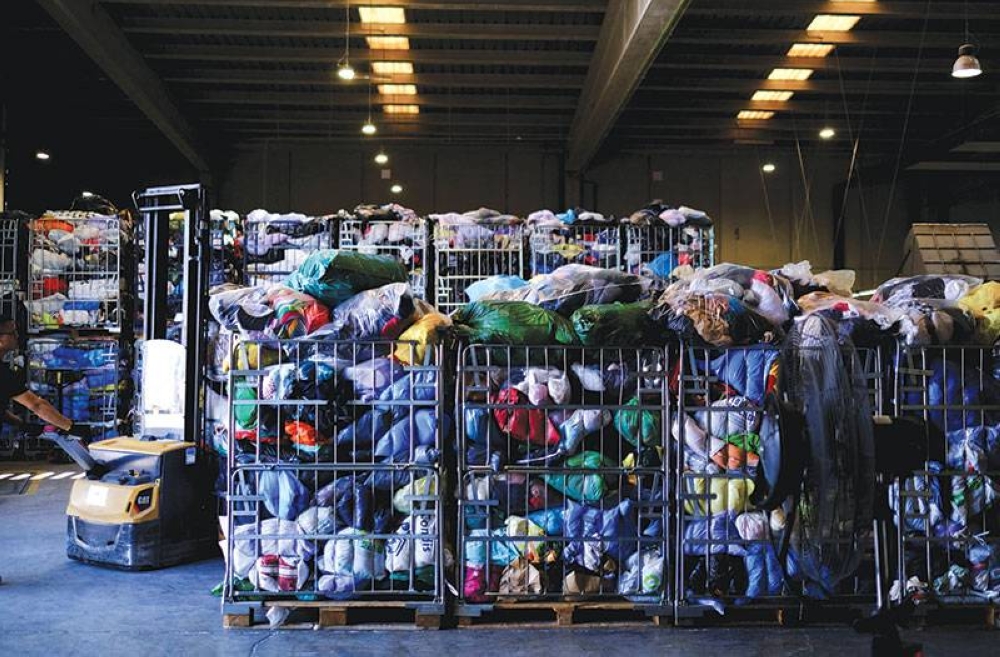In a warehouse on the outskirts of Barcelona, women stand at conveyor belts, manually sorting T-shirts, jeans and dresses from large bales of used clothing – a small step towards tackling Europe’s towering problem of discarded fashion.Within a year, the sorting centre run by garment reuse and recycling charity Moda Re plans to double the volume it handles to 40,000 metric tonnes annually.”This is just the beginning,” said Albert Alberich, director of Moda Re, which is a part of Spanish charity Caritas and runs Spain’s biggest second-hand clothing chain.”Increasingly we are going to turn used clothes into raw material from Europe for fashion companies.”Partly funded by Zara-owner Inditex, Moda Re will expand sites in Barcelona, Bilbao, and Valencia, in some of the first signs of a planned ramp-up in garment sorting, processing, and recycling capacity in response to a barrage of new European Union proposals to curb the fashion industry.Also in Spain, rivals including H&M, Mango and Inditex have created a non-profit association to manage clothing waste, responding to an EU law requiring member states to separate textiles from other waste from January 2025.Despite such efforts, less than a quarter of Europe’s 5.2mn tonnes of clothing waste is recycled and millions of tonnes ends up as landfill every year, the European Commission said in July.Precise data on the growth of clothing waste is scarce but collection for recycling and reuse increased gradually in several European countries from around 2010, a 2021 EU report said.Fast fashion, or making and selling cheap clothes with a short lifespan, is “highly unsustainable”, the commission said in July. The textile industry is a major contributor to climate change and environmental damage, it noted.Inditex, which in March said it placed 10% more items of clothing on the market globally last year than in 2021, aims to use 40% recycled fibres in garments by 2030 as part of sustainability goals announced in July.”The main problem that we are facing is overconsumption,” said Dijana Lind, ESG analyst at Union Investment, Frankfurt-based asset manager that holds shares in Adidas , Hugo Boss, Inditex, and H&M. Lind said she had been engaging with Adidas, Hugo Boss, and Inditex about the need for those companies to increase their use of recycled textiles, and for the apparel industry as a whole to increase textile recycling.Hugo Boss said in a statement that “overproduction and overconsumption are, in general, an industry-wide problem,” adding that it was using data analysis to better adjust production to demand. Between 6 and 7bn euros of investment will be needed by 2030 to create the scale of textile waste processing and recycling that the EU is aiming for, consultancy McKinsey estimated in a report last year.Lind said companies had introduced some first steps but “more needs to be done.”Inditex said it would invest 3.5mn euros in Moda Re over three years and had recycling containers in all its Spanish stores. It did not respond to a request for comment on the suggestion it needed to do more.In a statement, H&M said it recognised it was “part of the problem.””The way fashion is produced and consumed needs to change – this is an undeniable truth,” H&M said. The obstacles to significantly reducing clothing waste are formidable, despite the EU crackdown, industry sustainability commitments and initiatives like the Moda Re expansion.Hundreds of similar plants, along with investment in technology and market interventions will be needed to meet industry goals to recycle 2.5mn tonnes of textile waste by 2030, McKinsey said in the report. Fourteen textile recycling companies in Europe have plans to increase their production capacity, according to Fashion For Good, a recycled fibre start-up investment company that surveyed 57 recyclers in a September 2022 report.The EU has not set specific targets for recycled content in garments, but by 2030 aims for all textile products sold in the bloc “to a great extent” be made of recycled fibres, as well as being durable, repairable and recyclable.To create the capacity to meet the goals, ReHubs Europe, an association set up by garment lobby group EURATEX, promotes investments in “fibre-to-fibre” recycling: processes that turn used garments into yarn to make new textiles. EURATEX did not immediately respond to a question about the level of investments made in the technology.Less than 1% of clothes are currently recycled in this manner and the processes are still being developed. Challenges include separating different types of fibre into feedstock suitable for recycling.With such techniques still in their infancy, the higher cost of recycled fabric compared to new fabric remains a barrier to widespread adoption.At the Barcelona plant, garments arrive from more than 7,000 donation bins in supermarkets and Zara and Mango stores. Infrared machines donated by Inditex identify the fibre make-up of garments to speed up the largely-manual sorting.Currently around 40% of the clothes Moda Re receives are sent to other facilities for recycling. Of that, just a fifth is then recycled fibre-to-fibre, a share that Moda Re expects will grow to 70% over the next three to four years.For now, most of the recycling is instead for lower grade products like dishcloths.Almost half the clothes donated to Moda Re are shipped for resale in African countries including Cameroon, Ghana, and Senegal. Moda Re says the clothes it exports can be reused.According to United Nations trade data, the EU exported 1.4mn tonnes of used textiles in 2022, more than twice as much as in 2000. Not all those clothes get reused, and exports of used clothes from Europe to Africa can lead to pollution when clothes that can’t be resold end up in dumps, the EU has said.Proposed European Commission rules seek to clamp down on unscrupulous operators that export damaged items destined for dumps, and would require countries to demonstrate their ability to manage the material sustainably.Moda Re said it aims to reduce the volume of clothes it sends to Africa.- Reuters

